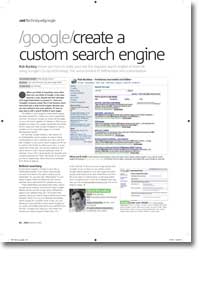
The best Firefox extensions for developers
- Article 1 of 3
- .net, May 2006
Firefox has now been downloaded 165,123,014 times, inspiring hundreds of fantastic extensions. Rob Buckley presents the fifteen you really can't afford to miss.
Page 1 | Page 2 | Page 3 | Page 4 | Page 5 | All 5 Pages
At the top of the list of things for web developers to remember should be a reminder that whatever can go wrong, will go wrong. Only the simplest of web page designs can make it from authoring app to the real world without having to undergo a few tweaks caused by browser incompatibility, accessibility problems, server issues or coding mistakes.
The main issues arise from the fact that pinning down problems in web pages really isn’t as simple a task as you might hope. Web browsers are designed to be easy to use, so filling them up with complex debugging tools is not an ideal solution. Browser developers might not be interested in adding webdebugging tools to their software, but that doesn’t mean no one else can. If a browser has a simple, open extension architecture, anyone can add new features to it and make it do more or less anything they want.
The most extensible of all browsers is Firefox, which now has over 1,000 extensions. These are almost all cross-platform, so they work on Macs and Linux machines as well as Windows. They include debugging consoles, syntax validators, cookie manipulators, accessibility tools, manuals, measurement tools and search engine optimisation information. Add to that extensions that can rewrite the pages and stylesheets you’re using and suddenly Firefox becomes by far the most developer-friendly of all the browsers available.
Over the next three pages, we’re going to show you what the best 15 Firefox extensions can do for you, as well as look at some of the plug-ins available for other browsers. Installing an extension is easy: just click on the install link provided on each download page, give the site permission, and Firefox will be able to download and install the extension. Provided it’s compatible with the version of Firefox you’re using, the extension should be up and running as soon as you restart the browser.
1 Web Developer
http://chrispederick.com/work/webdeveloper
If there’s one Firefox extension to rule them all, it’s the Web Developer toolbar. It has a huge number of features, so we’ll start with the most useful. Often, you’ll need to work out exactly which styles apply to a page element with Web Developer installed, just click ‘View Style Information’ and every time you mouse over an element, the styles applied to it will appear in your status bar.
And there are plenty more goodies: you can outline highlights, common elements and links without title tags; images show sizes, alt tags and oversized images; forms enable you to manipulate form elements and submission methods; cookies enable you to add, delete and disable cookies; and there’s much more. Indispensable!
2 Mozilla Accessibility Extension
http://cita.disability.uiuc.edu/software/mozilla/
Virtually every company and site owner needs to ensure their web pages are accessible to disabled users as well as the able-bodied. The Mozilla Accessibility Extension provides a toolbar that gives non-disabled designers a taste of what it’s like to be a disabled web user, as well as giving disabled users a selection of tools to help with their browsing experience.
In addition to exposing the images that don’t have alt or longdesc tags, it enables you to disable certain mouse events, so you know how the page behaves when someone’s not using a mouse to navigate it. You can also deactivate formatting to see how well your layouts survive when reduced to their most accessible.
Page 1 | Page 2 | Page 3 | Page 4 | Page 5 | All 5 Pages

